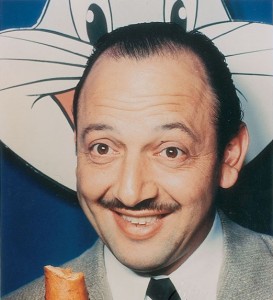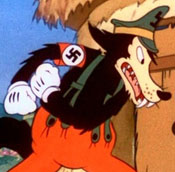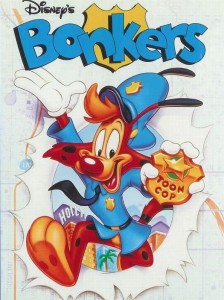Once Upon a Forest. Once Upon a Forest (1993) began in Wales as an idea for a television series with environmental undertones. Mark Young and co-writer Kelly Ward at first felt there wasn’t enough there to make an animated series. Young went on to other things.
 “I saw a blurb in the paper about an animation writing class and I thought it would be a fun little hobby,” stated Young who ended up being invited to pitch a The Jetsons pilot to Joe Barbera himself and ending up being offered a job. “It was twice the money for just sitting in a room and writing.”
“I saw a blurb in the paper about an animation writing class and I thought it would be a fun little hobby,” stated Young who ended up being invited to pitch a The Jetsons pilot to Joe Barbera himself and ending up being offered a job. “It was twice the money for just sitting in a room and writing.”
He moved over to MGM where he and Ward began trying to punch up the script they had been working on in Wales and ended up writing their own music for the pilot. They had renamed the project “The Endangered” and a new executive at the studio looked at the project and offered them twelve million to expand it into an animated feature.
Young told the Newport News-Hampton Virginia Daily Press on May 8, 1993: “It took us about three years off and on. The story still holds. It has a lot of integrity. It’s a sweet little film. We didn’t want to hit kids over the head with environmental messages. We’re not dyed-in-the-wool environmentalists, but we are concerned.
“The story is about a wood mouse, a hedgehog and a mole that set off to find special herbs to heal a young badger whose eyes and lungs were burned by noxious fumes from a chemical spill. They encounter a choir-leading crested grebe, whose voice was dubbed by Ben Vereen, and other characters along the way. Actress Glenn Close recorded a voice for the film but her part wound up on the cutting room floor. That’s something to put on my resume: the only guy to cut Glenn Close.”
 Consummate Actor Mel Blanc. Noel Blanc was interviewed about his dad, voice artist Mel Blanc, in a June 1993 issue of Antique & Collectables magazine. “My dad was an incredible Stanislavski method actor. He was the Actors’ Studio personified. When he became a character in his voice, his whole countenance, his whole body changed. You could take still photos of him doing Bugs, Porky, Daffy, Sylvester, Tweety and just from the still photos you could tell what character he was doing because his body became that character. It was very wild. He was a consummate actor.
Consummate Actor Mel Blanc. Noel Blanc was interviewed about his dad, voice artist Mel Blanc, in a June 1993 issue of Antique & Collectables magazine. “My dad was an incredible Stanislavski method actor. He was the Actors’ Studio personified. When he became a character in his voice, his whole countenance, his whole body changed. You could take still photos of him doing Bugs, Porky, Daffy, Sylvester, Tweety and just from the still photos you could tell what character he was doing because his body became that character. It was very wild. He was a consummate actor.
“I was just going through some of his old things and came across a photo of Bud Abbott and Lou Costello that they signed ‘To my favorite actor, Mel Blanc’. They all considered him to be the consummate actor. Around the house, my dad was just a regular dad. He could have been a shoe salesman from Des Moines.”
 Disney Goes To War. At the Annecy International Animated Film Festival in France in 1989, the Disney Company allowed six of its anti-Nazi films to be shown for the first time in over forty years. Only one thousand people were able to see the one-time screening but the festival officials received more than three thousand requests, mostly from professionals to attend the event.
Disney Goes To War. At the Annecy International Animated Film Festival in France in 1989, the Disney Company allowed six of its anti-Nazi films to be shown for the first time in over forty years. Only one thousand people were able to see the one-time screening but the festival officials received more than three thousand requests, mostly from professionals to attend the event.
“It is absolutely acceptable to present these films from the war period to professionals, to people able to appreciate this type of animation in its context but it wouldn’t be right to reproduce them on cassettes or to edit them for the public. That would not reflect the spirit of Disney today. Walt Disney has always had a progressive image, and one must situate these clips in their right context,” said Disney Studio senior vice president Peter Schneider.
The Secret To Success. Former Disney CEO Ron Miller was a witness in the trial of stockholder lawsuits accusing Disney and its directors of paying “greenmail” in 1984 to Saul Steinberg. Miller got a laugh from the jury when his own attorney asked him how he got his first job at the company and he replied, “I married Walt’s daughter.”
 Going Bonkers! Bob Taylor, supervising producer of Disney’s Bonkers! animated television series where an out-of-work Toon character, Bonkers D. Bobcat, joins the Hollywood Police Department’s Toon Division headed by human detective Lucky Piquel told the media in 1993: “Bonkers! is really about what happens when two worlds collide. The Toon world and the human world each have a different set of rules, different behaviors and different looks.
Going Bonkers! Bob Taylor, supervising producer of Disney’s Bonkers! animated television series where an out-of-work Toon character, Bonkers D. Bobcat, joins the Hollywood Police Department’s Toon Division headed by human detective Lucky Piquel told the media in 1993: “Bonkers! is really about what happens when two worlds collide. The Toon world and the human world each have a different set of rules, different behaviors and different looks.
“Bonkers brings a Toon’s childlike enthusiasm to everything he does. He’s a naïve ‘wanna be’ whereas Piquel is a ‘used to be’ or ‘thought he’d be’. Piquel is the original ‘poor soul’.”
Actually, Bonkers was created so that Disney could have a Roger Rabbit type of character that it owned completely without having to worry about approval or sharing the profits with Steven Spielberg and Amblin Entertainment. Voice artist Jim Cummings did the voice of both Bonkers and Piquel. Instead of combining live action and animation, it was less expensive to do it all in animation.
Disney publicity stated that this was an advantage and that “humans are rendered in simple greyed hues while Toons are drawn with bright primaries and no shadow colors, giving them a more two-dimensional look. This effect makes the humans appear muted while the Toons seem to jump off the screen”.
 Burton on Strong Animated Women. One of Tim Burton’s favorite characters in The Nightmare Before Christmas (1993) was the rag doll Sally. Burton told Adweek magazine in October 1993, “I get so tired, especially in animated movies lately where they try to make the woman strong which I find paternalistic. Why not let characters be what they are and whatever strength that comes out is really what is there? It’s nice to see a character like Sally who’s in love with somebody and is not diminished by just showing that kind of emotion.”
Burton on Strong Animated Women. One of Tim Burton’s favorite characters in The Nightmare Before Christmas (1993) was the rag doll Sally. Burton told Adweek magazine in October 1993, “I get so tired, especially in animated movies lately where they try to make the woman strong which I find paternalistic. Why not let characters be what they are and whatever strength that comes out is really what is there? It’s nice to see a character like Sally who’s in love with somebody and is not diminished by just showing that kind of emotion.”
Nightmare Animation. Supervising animator Eric Leighton on The Nightmare Before Christmas (1993) told USA Today in 1993 that a circus clown was hired to work with the animators on movement. The idea “was to get the animators to free up their bodies and learn to express themselves through mime and then transfer that skill into the puppets. In addition, to capture the elegant movements needed for Jack, we watched tapes of Fred Astaire and Tommy Tune”. A masseuse came weekly to rub sore backs, cramped necks and arching shoulders. An on-set ping pong table and punching bag helped keep hands and wrists limber.


 Jim Korkis is an internationally respected animation historian who in recent years has devoted his attention to the many worlds of Disney. He was a columnist for a variety of animation magazines. With his former writing partner, John Cawley, he authored several animation related books including The Encyclopedia of Cartoon Superstars, How to Create Animation, Cartoon Confidential and Get Animated’s Animation Art Buyer’s Guide. He taught animation classes at the Disney Institute in Florida as well as instructing classes on acting and animation history for Disney Feature Animation: Florida.
Jim Korkis is an internationally respected animation historian who in recent years has devoted his attention to the many worlds of Disney. He was a columnist for a variety of animation magazines. With his former writing partner, John Cawley, he authored several animation related books including The Encyclopedia of Cartoon Superstars, How to Create Animation, Cartoon Confidential and Get Animated’s Animation Art Buyer’s Guide. He taught animation classes at the Disney Institute in Florida as well as instructing classes on acting and animation history for Disney Feature Animation: Florida.




















































Sadly that what ruined Bonkers. I liked him better when he was on Disney’s Raw Toonage in the He’s Bonkers segment. The idea where Bonkers was a officer on the Hollywood Police Department in Hollywood California, fact is The Los Angeles Police Department (LAPD) serves police patrol in the city of Hollywood as the Hollywood Division of the LAPD while the real Hollywood Police Department is located in the city of Hollywood Florida. And making it a Roger Rabbit like series didn’t make any sense due to most of the characters that was on Bonker were created by Disney and not of the other studios like Warners Bros,Paramount,Universal and others that were in Who Framed Roger Rabbit (and it took place around 53 years later after Roger Rabbit), and with a bunch of unknown cartoon characters that where never seen before and were exclusive to Bonkers.
Hey, I didn’t think the series was bad. It’s not like Famous/Paramount didn’t do the same thing when they created Little Audrey.
Besides, there’s are obvious reason why none of the other studios’ characters were not on the show. You really think Warners would allow their characters to be on another studio’s show when they already were starting their own cartoon about fictional Golden Age cartoon characters?
I’ve always thought of Mel Blanc as the “consumate actor”, even when he’s doing a character with limited dialogue, mostly grunts and groans and yowling, like the Papa Gorilla in “GORILLA MY DREAMS”. Sure, you could probably get someone else to do that voice, but it just wouldn’t be the same, because it is more than just the groans and grunts and yowling…it’s the sound of the reaction when Bugs slams him over the head to calm him down…and I’m still trying to figure out that snorting growl that is the lion in “ACRO-BATTY BUNNY” Hanna-Barbera must have thought enough of Mel’s “animal grace” because they used his snarl to represent this lizard or dragon-like creature in an episode of “JONNY QUEST”; it didn’t quite work for me, because I’m not sure that a dragon or lizard, even of that size, would make any noise at all, and I’ve always connected that growl with the comedy in LOONEY TUNES, as mentioned above, so it made me giggle where I should normally feel the suspense of the moment. You almost expected Jonny to step back and say something to the dragon like “…Hmmm, you got a good point, d’ere, Nero!” But ya gotta hand it to Mel, even during that period when it was already becoming taxing on him to do such full-on voice work, he could still let out a gutteral growl like that! Truly amazing, and I doubt that we’ll ever see the like of him again, simply because we’re not creating memorable cartoon characters like that anymore!
Jim, you did not say anything about the troubled development of “Bonkers”.
The original concept of “Bonkers” was for him to have a female partner named Miranda Wright (voiced by Danny DeVito’s daughter, Karla). Duane Capizzi was the original supervising producer. Around 20 eps of the original concept were finished, wherein many Disney characters as well as “He’s Bonkers” shorts cast members had frequent cameos. But for a reason I don’t know, the animation for “Bonkers” episodes turned out to be disastrously bad. You can see that in some of the eps that got finished, such as “Dog Day AfterToon”. Somehow, the problem got so bad that Capizzi and his staff got sacked.
That’s when Bob Taylor came. The solution of his staff was to restart from scratch with Lucky Piquel as Bonkers’s partner. Chief Kanifky (voiced by Earl Boen from “The Terminator) was the only old premise character to continue in the new premise. The continuity was written such that the old premise eps happen after the new premise eps, wherein Lucky had moved away to an FBI job and Wriight got a promotion from a secretary job to a partner job.
Karla DeVito is not Danny DeVito’s daughter; they are apparently completely unrelated.
Karla was (or is) married to Robby Benson.
It’s rather interesting how they did that just to be able to use those previous episodes at all. One thing I will say is that I do miss Bonkers’ golf club-like ears he had in the original Raw Toonage shorts and the Miranda episodes. That was the only part of him I thought was distinctive enough instead of the more stringy Goofy/Pluto ears they gave him later.
@Nik Kramer
What would of been cool is that they could of have some of the “newer” cartoon characters such as Yogi Bear,Scooby Doo and The Flintstones (Hanna Barbera), The Brady Kids,Archie and his friends, Sabrina the Teenage Witch (Film
Cont. -Mation several international cartoon characters like Speed Racer,Sally the Witch,Astro Boy (Japan) Tintin (Belgium) King Rollo,Towser,Roobarb(England) Mio & Mao (Italy) as well as American favorites like Rocky and Bullwinkle,George of the Jungle,Batfink and Milton the Monster to spice up the series.
Well, considering the fact that Roy did produced the “All Star” special a few years before, I can what your coming from. But I’m still not sure other studios would be willing to collaborate on a TV series for Disney.
I do think it would be possible to have more Disney characters to cameo on “Bonkers” during the later “Bucky” episodes. Although, this was back when Disney Television still couldn’t officially use Mickey due to Roy’s wishes (this rule, of course, changed by the end of the decade). “Bonkers” did do a loop hole in one episode where Mickey was kidnapped, but he never appeared onscreen and was only addressed as Mr. Mouse, yet, Wayne still performed him anyway.
Bonkers was never going to be a Roger Rabbit cartoon. Greg Weisman worked on the original Bonkers episodes and debunked that on a forum a while back.
http://www.s8.org/gargoyles/askgreg/search.php?qid=10210
“Q; Is it true that Bonkers was originally conceived as a Roger Rabbit TV series, but the Roger Rabbit were replaced due to Spielberg and his Amblin Entertainment company and Gary K. Wolf co-owning Roger Rabbit along with Disney? :”
A: No, that’s not true. Certainly, Roger provided inspiration for Bonkers. And I suppose one could say that if some higher up had come to us and said, “Do you want to do the TV version of Roger Rabbit ?” (which never happened) than we would have jumped at the chance and most likely Bonkers never would have happened.
But Bonkers was developed as its own entity, originally entitled “Toon Cop”. Roger was never our Toon Cop. “
Thanks for clearing that up for us. I can see why some may think that way at all when it comes to Bonkers and the similarities to Roger in a few places.